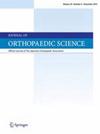莫顿神经瘤的跖骨滑动截骨术在不改变足底压力的情况下是有效的:回顾性病例系列。
IF 1.5
4区 医学
Q3 ORTHOPEDICS
引用次数: 0
摘要
背景:治疗莫顿神经瘤的各种手术方法已经被讨论过,最近也有跖骨截骨术的报道。然而,尚无跖骨截骨术后的足造影改变的报道。术后其他跖骨区足部造影改变可引起转移性跖骨痛,围手术期应充分分析足部造影资料。本研究的目的是探讨第3跖骨滑动截骨术治疗莫顿神经瘤的术后足镜变化。方法:回顾性分析2013年11月至2021年12月行第3跖骨滑动截骨术治疗莫顿神经瘤的40例(45英尺)患者。经背侧入路对第三跖骨近端行近端滑动截骨术。临床结果采用美国骨科足踝学会小跖趾指间量表(AOFAS LMIS)、足功能指数(FFI)和视觉模拟量表(VAS)进行评估。行x线平片和儿童钡剂造影以评价放射学和儿童钡剂造影结果。结果:AOFAS评分由52.8±9.0(18-62)分改善至88.8±9.8(78-100)分,FFI评分由61.8±4.9(50-70)分改善至32.2±5.1(23-42)分。术后第3跖骨缩短3.1±0.8 mm,背侧移位1.5±0.4 mm。足底第2、第3、第3、第4跖骨头之间的跖间距离术后明显增加。术前和术后2 ~ 4跖头平均前足压力和最大压力无明显变化。结论:第3跖骨近端滑动截骨术在临床和足镜检查中均取得满意的效果。它可以有效地治疗莫顿神经瘤的永久间接减压,避免神经瘤复发、组织粘连、感觉异常和转移跖痛。本文章由计算机程序翻译,如有差异,请以英文原文为准。
Metatarsal sliding osteotomy is effective without altering plantar pressure in Morton's neuroma
Background
Various operative methods for the treatment of Morton's neuroma have been discussed, and osteotomy of the metatarsal bone has been reported recently. However, there has been no report of pedobarographic changes after metatarsal osteotomy. Pedobarographic changes of other metatarsal area after the surgery may cause transfer metatarsalgia, and thorough analysis of the pedobarographic data should be performed peri-operatively. The purpose of this study is to investigate the post-operative pedobarographic changes of sliding osteotomy of the 3rd metatarsal bone for treating Morton's neuroma.
Methods
Forty patients (45 feet) who underwent metatarsal sliding osteotomy of the 3rd metatarsal bone for treating Morton's neuroma from November 2013 to December 2021 were retrospectively reviewed. Proximal sliding osteotomy was performed at the proximal 3rd metatarsal bone through dorsal approach. Clinical outcomes were evaluated with American Orthopaedic Foot and Ankle Society Lesser Metatarsophalangeal Interphalangeal Scale (AOFAS LMIS), Foot Function Index (FFI), and Visual Analogue Scale (VAS). Plain radiograph and pedobarogram were performed to evaluate the radiologic and pedobarographic outcomes.
Results
AOFAS score was improved from 52.8 ± 9.0 (18–62) to 88.8 ± 9.8 (78–100) and FFI was improved from 61.8 ± 4.9 (50–70) to 32.2 ± 5.1 (23–42) on average. The 3rd metatarsal bone was shortened by 3.1 ± 0.8 mm and dorsally shifted by 1.5 ± 0.4 mm after the surgery. Plantar intermetatarsal distances between 2nd and 3rd and 3rd and 4th metatarsal heads were significantly increased post-operatively. Average forefoot pressure and maximum pressure of the 2nd to 4th metatarsal head were not significantly changed between pre-operatively and post-operatively.
Conclusion
Proximal metatarsal sliding osteotomy of the 3rd metatarsal bone shows a satisfactory result in both clinical and pedobarographical evaluations. It could be an effective treatment of permanent indirect decompression of Morton's neuroma with avoiding recurred neuroma, adhesion of tissue, paresthesia, and transfer metatarsalgia.
求助全文
通过发布文献求助,成功后即可免费获取论文全文。
去求助
来源期刊

Journal of Orthopaedic Science
医学-整形外科
CiteScore
3.00
自引率
0.00%
发文量
290
审稿时长
90 days
期刊介绍:
The Journal of Orthopaedic Science is the official peer-reviewed journal of the Japanese Orthopaedic Association. The journal publishes the latest researches and topical debates in all fields of clinical and experimental orthopaedics, including musculoskeletal medicine, sports medicine, locomotive syndrome, trauma, paediatrics, oncology and biomaterials, as well as basic researches.
 求助内容:
求助内容: 应助结果提醒方式:
应助结果提醒方式:


